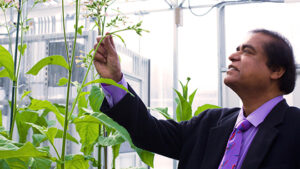Penn Researchers Design a Program that Coaxes Plants to Produce Human Clotting Factor for Hemophilia
Researchers from the University of Pennsylvania’s departments of Biochemistry and Pathology in the School of Dental Medicine have used codon optimization to create a genetic engineering technique that persuades lettuce and tobacco plants to produce foreign proteins.
The applications include producing the clotting factor to make hemophilia treatments, or a polio virus to make vaccines.
In the study “Codon Optimization to Enhance Expression Yields Insights Into Chloroplast Translation,” Henry Daniell, PhD, professor in the departments of Biochemistry and Pathology in the School of Dental Medicine, and his team set out to investigate why his plant-based drug production platform can easily express bacterial genes as well as short human genes, but has difficulty expressing viral genes and longer human genes.
One reason for this, the team hypothesized, could be how different organisms such as plants and viruses use DNA code to make proteins.

“Plant chloroplasts are bacteria-like, or prokaryotic, and humans are eukaryotic,” Daniell told the Penn Current. “So that’s the challenge: How can we make a chloroplast recognize a human gene and transform it like its own to make a protein?”
In the study, published in Plant Physiology, Daniell explained how proteins are made up of building blocks called amino acids, which are produced according to three-letter strings of DNA called codons. There are 64 codons but only 20 amino acids, because multiple codons encode the same amino acid. However, Daniell discovered that different organisms have different preferences for which codon they use to produce a given amino acid.
Researchers focused on these species-specific preferences by analyzing the genomes of 133 plant species to determine which codons were used most frequently to code for particular amino acids. They then used the results to design a software program that converts a DNA sequence into the sequence that would be preferred by either lettuce or tobacco plants.
According to Penn Current, the team then used a head-to-head comparison of the optimized gene versus the native gene in two different proteins: one used in a hemophilia therapy, and one in a polio vaccine. The research team, working with Novo Nordisk, developed a technique involving a probe to the protein of interest to arrive at an exact quantity in the finished batches.
The findings revealed codon-optimization has a significant impact on protein expression: The process led to expression levels of hemophilia clotting factor five to six times higher than the native protein, and to higher levels of the poliovirus protein roughly 26 times that of the native sequence.
“These two advances — improving the expression levels of protein and quantifying an exact dose — were key questions the [U.S. Food and Drug Administration] has had about our work,” said Daniell to Penn Current. “Now that we’ve addressed these issues, we’re closer than ever to getting these therapies to the clinic.”


